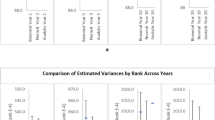Abstract
We explore the optimization of US Army officer force profiles. An officer force profile describes the distribution of rank and specialty as well as age and experience within the officer corps. There are two different force profiles, the one that dictates the requirements or targets for a given force structure and one that defines the current population. We explore and optimize a force profile that meets current and future force structure requirements while incorporating information from the current and historical officer population. We propose a new network structure that incorporates both rank and years in grade to combine cohort, rank, and specialty modeling without falling into the common pitfalls of small cell size and uncontrollable end effects. This research is the first to address specialty and experience modeling in a manpower and force development model for US Army officers, modeling the entire officer’s career and developing an optimal force profile.



Similar content being viewed by others
References
Cashbaugh, D., Hall, A., Kwinn, M., Sriver, T., Womer, N.: Manpower and personnel. In: Rainey, L., Loerch, A. (eds.) Methods for conducting military operational analysis. Military Operations Research Society (2007)
Collins, R.W., Gass, S.I., Rosendarl, E.E.: The ASCAR model for evaluating military manpower policy. Interfaces 13(3), 44–53 (1983)
Gass, S.I.: Military manpower planning models. Comput. Oper. Res. 18(1), 65–73 (1991)
Grinold, R.C.: Manpower planning with uncertain requirements. Oper. Res. 24(3), 387–399 (1976)
Grinold, R.C.: Model building techniques for the correction of end effects in multistage convex programs. Oper. Res. 31(3), 407–431 (1983)
Grinold, R.C., Stanford, R.: Optimal control of a graded manpower system. Manag. Sci. 20(8), 1201 (1974) (0025–1909)
Hall, A.O.: Validation of the enlisted grade model gradebreaks. In: WSC ’04: Proceedings of the 36th Winter Simulation Conference, pp. 921–925. IEEE (2004)
Henning, C.A.: Army officer shortages: background and issues for congress. Tech. rep., Congressional Research Service, the Library of Congress. Fort Belvoir (2006). http://handle.dtic.mil/100.2/ADA462381
Henry, T.M., Ravindran, A.R.: A goal programming application for Army officer accession planning. INFOR 43(2), 111–119 (2005)
Holz, B.W., Wroth, J.M.: Improving strength forecasts: Support for Army manpower management. Interfaces 10(6), 37–52 (1980)
Price, W.L., Piskor, W.G.: The application of goal programming to manpower planning. INFOR 10(3), 221–231 (1972)
Shrimpton, D., Newman, A.M.: The US Army uses a network optimization model to designate career fields for officers. Interfaces 35(3), 230–237 (2005)
Author information
Authors and Affiliations
Corresponding author
Rights and permissions
About this article
Cite this article
Hall, A.O., Fu, M.C. Optimal Army officer force profiles. Optim Lett 9, 1769–1785 (2015). https://doi.org/10.1007/s11590-015-0947-7
Received:
Accepted:
Published:
Issue Date:
DOI: https://doi.org/10.1007/s11590-015-0947-7




